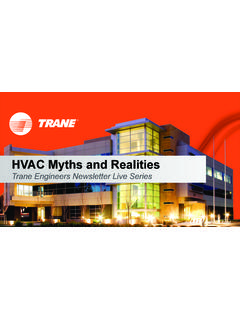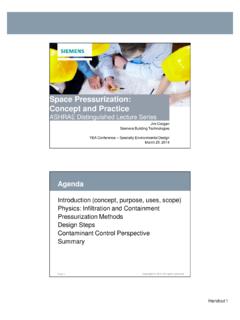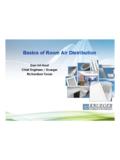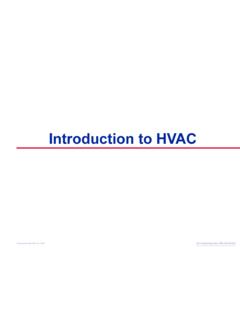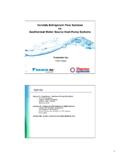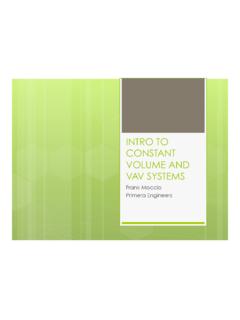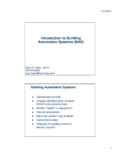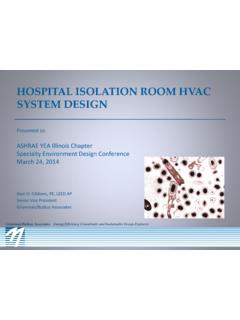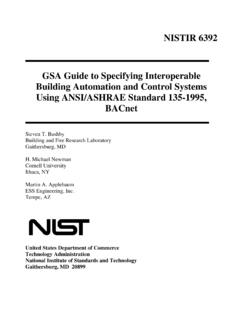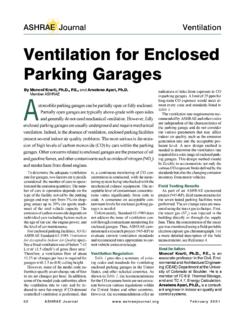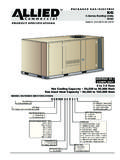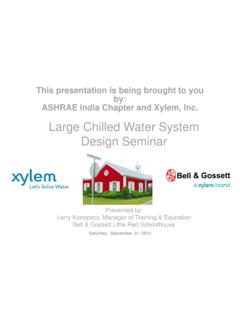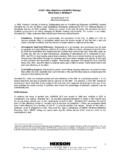Transcription of ASHRAE Indoor Air Quality Guide - ASHRAE® …
1 ASHRAE Indoor Air Quality GuidePresented For:Chicago ASHRAEBy:James Livingston, Regional Sales Manager, Ruskin Company1 Purpose of Presentation Comment on ASHRAE IAQ Guide topics as related to air control devices Provide information on the function and benefits of these devices Provide advice on their application2 Presentation Agenda3 IAQ Guide BasicsObjectives1 Design & Construction2 Control Moisture4 Moisture in HVAC6 Capture/Exhaust Contaminants7 Reduce Contaminants8 Advanced Ventilation ApproachesPurpose of IAQ Guide Provide advice on how provide good IAQ via means that are: Cost effective Practical Currently available Technologically sound Sustainable Goal: Increased usage & IAQ!4 Guide Approach 8 Objectives Objectives address components of building IAQ Each Objective contains individual Strategies to help achieve the Objective Benefits designers, constructors, owners and facility managers5 Scope of IAQ Guide Buildings covered: Commercial & institutional Office Retail Educational Lodging Public assembly6 Scope of IAQ Guide Buildings not covered: Kitchens Medical procedure rooms Natatoriums Cold buildings Laboratory Industrial Residential Chemical storage7 Why IAQ?
2 Health & well being of occupants Financial success & sustainability of building8 Common Sources of Poor IAQC ommon Sources of Poor IAQ Two Basic Categories Gaseous Radon, C02, chemical vapors, etc. Biological (with 2 subcategories) Microbial Bacteria, molds, mildews, viruses, dust mites, animal dander, etc. Particulate Dust, pollen, building material fibers, process byproduct (such as saw dust), etc. THE SOLUTION TO THE SOLUTION TO THE SOLUTION TO THE SOLUTION TO POLLUTION IS DILUTION POLLUTION IS DILUTION POLLUTION IS DILUTION POLLUTION IS DILUTION W. Issues Increased allergy & asthma symptoms Colds & infections Carbon monoxide poisoning Legionnaires disease Lung cancer from Radon exposure10 Financial Impact Repairs or modifications to correct issues Potential temporary building closure Difficulty in renting spaces Legal action due to sick building or other issues11A Different Way Of Thinking Traditional high priority features include cost, space, aesthetics, etc.
3 Make IAQ a priority in the beginning! Early discussions & strategies by all parties Improving IAQ after the fact is difficult and sometimes impossible12 Objective 1 Manage the Design & Construction Process to Achieve Good IAQ S trategy Traditional Design13 Objective 1 Strategy Integrated Design14 Objective 1 Strategy Commissioning Not just post-construction Employ a Commissioning Authority (CxA) for pre-design and during construction Ensure the design meets owners requirements and is being constructed correctly15 Objective 1 Strategy Selecting HVAC Systems Use environmentally-friendly & energy efficient systems when possible Displacement ventilation If conventional means are used (CV, VAV, etc.), be sure good IAQ practices are used ( ventilation for example).
4 16 Objective 1 Strategy Effective Operation & Maintenance O&M can be just as important as design & construction Expected level of owner s O&M efforts? Consider O&M during design & construction Provide documentation & training17 Objective 2 Control Moisture in Building Assemblies M oisture is a common cause of IAQ problems and responsible for the most costly litigation and remediation Thermal bridging enables interior frost build-up & condensation Condensation liquid can travel through capillary action to inaccessible locations18 Objective 2 Strategy Limit Condensation of Water Vapor within the Building Envelope and on Interior Surfaces Use Thermally Efficient (Insulated) Control Dampers at outside air intakes19 Strategy Why use Thermally Efficient Dampers?
5 Reduce condensation to prevent bacteria, mold, mildew Thermally broken to prevent frost build-up Lessen leakage into or out of space Generally Class 1 leakage 4 cfm/ft at 1 500-D Section Thermal Efficiency Test Test setup Figure Damper tested in both airflow directions 2 F Steady State Temperature for a period of 10 minutes Applied torque AMCA 500-D V-groove reference damper 9 cfm per square foot at 1 How much more efficient is the test damper when compared to the reference damper? Insulated & thermally broken blades Blade & jamb seals for low leakage Thermally broken frames Non-metallic bearingsThermally Efficient Damper Features AMCA Standard 500-D AMCA certified leakage AMCA certified performance AMCA certified Thermal EfficiencyThermally Efficient Damper PerformanceObjective 2 Strategy Maintain Proper Building Pressurization Building pressure affects moisture infiltration and exfiltration Negative pressure in hot, humid conditions promotes moisture infiltration into spaces Positive pressure in humid spaces increases condensation buildup within envelope25 Strategy Pressurization often is not consistent throughout building due to.
6 Stack effect Wind speed & direction Temperature HVAC supply & exhaust rates26 Strategy Airflow measuring stations can assist with pressurization27 Pick the Product for the Application Use Electronic Air Flow Measurement for very low velocities and large openings Use Velocity Pressure Measurement for high velocities or small openings. Electronic Airflow Measuring Thermistors, heated mass flow sensors, hot film anemometers, etc. Measures energy to heat element Low velocities as little as 0 fpm 29Pv = Pt - PsPsPtTotal Pressure ChamberStatic Pressure ChamberVelocity Pressure Airflow Measuring Differential Pressure Minimum 300 fpmLocations For Airflow Measuring StationsSuggestions for Measuring Outside Air32 VAV & CV Systems Air measuring station w/ control damper built-in Damper control is manual or by BASDCV Systems Air measuring station with built-in control damper and control system Control system maintains CFM set point as fans scroll up and downAny system.
7 Limited space Air measuring combined with outside air louver Can be as little as 4 total depthSuggestions for Measuring Supply Air33 Fan inlet Highest velocity point in the system Total system supply airflowRetrofit single floor or pressure area Probes or stations Can install as close as 4 in front of existing dampersNew construction single floor or pressure area Air measuring station w/ control damper built-in Damper control is manual or by BASS uggestions for Measuring Return Air34 Retrofit single floor or pressure area Probes or stations Can install as close as 4 in front of existing dampersNew construction single floor or pressure area Air measuring station w/ control damper built-in Damper control is manual or by BASS uggestions for Measuring Exhaust Air35 Use velocity pressure probes or stations Works well with high velocity exhaust airflow Much less expensive than electronic airflow stationsObjective 4 Control Moisture & Contaminants Related to Mechanical Systems S trategy Control Moisture and Dirt in Air-Handling Systems Fungi & bacteria are normally present on building interior surfaces, including HVAC components Microorganism growth in HVAC system results in malodors.
8 Nasal & throat irritation and building-related illnesses36 Strategy Outside air louvers can prevent rain penetration37 LouversLouvers With Plenum Behind38 Water Penetration39 Sloped Plenum Detail40 Strategy Traditional louvers provide protection from non-storm rain Wind Driven Rain Resistant louver provide storm condition protection Let s look at the T raditional Louvers: Horizontal blades Drain Gutters Wide Spacing High Free Area Low Cost Stops some rain Not effective in storms42 Strategy Traditional louver sizing AMCA Water Penetration test Beginning Point of Water Penetration free area velocity (FAV) Determine design FAV considering AMCA test data CFM/FAV = Total Free Area required Reference louver Free Area Guide to determine appropriate louver size43 Air ExhaustWaterDropletsWaterdrop ManifoldWetted Wall ManifoldTest UnitAir Entrained into chamber through louverAir FlowMeasurementCollectionZoneExhaustFan Still Air Condition!
9 Standard 500-L Water PenetrationTest Conditions 48 x 48 size 15 minute intervals Manifold (raindrops) - 4 per hour ( gal/15 min) Wetted wall - .25 gpm ( gallons/15 min) Ventilation airflow only no wind 1250 fpm max free area velocityStandard 500-L LouversAMCA Still Air Water TestWater Penetration GraphBeginning Point Of Water Penetration: .01 oz/ft at 1,023 fpm Free Area of free area Still Air Test with Non-drainable LouverTraditional Louvers Where to use: Properly drained applications Sloped plenums & ductwork Floor drains Protected areas (overhangs, barriers, interior, non-prevailing wind elevations) Screen applications (vision barriers) Sizing Use Safety Factor (15% to 20% min) Does NOT stop storm rainTraditional Drainable Louver29 mph wind, 3 /hr rain, 1,000 fpm intake velocityNew Louver Technology W ind Driven Rain Louvers Horizontal or Verticalblades Drain Gutters on horizontal Hooks on vertical Close spacing Lower Free Area Higher Velocity Effective in storms5152 Wind/RainMachineTest LouverWind DrivenRain plusAir EntrainedInto ChamberThrough LouverAir ExhaustExhaust FanCollection ZoneRain WaterDischargeNozzlesStd 500-L Wind Driven Rain Water Rejection Wind Driven Rain Rejection Effectiveness ClassesA 99% to 100%B 95% to to 80%D below 80% (std.)
10 Louvers) 3 rain/29 mph wind 8 rain/50 mph wind53 Std 500-L Wind Driven Rain TestWind Driven Rain Louver29 mph wind, 3 /hr rain, 2,000 fpm intake velocityRear view, 29 mph wind, 3 /hr rain, 2,000 fpm intake velocityHow Much Water Is Applied? 3 Per Hour Rain On 1m X 1m 21 Gallons Applied Over 1 Hr. Class A (99% or better) allows 27 fl. oz penetration Class D (80% or worse) allows over 4 gallons Std Louvers (60% or lower) - over 7 gallonsWind Driven Rain Louver Benefits Prevent rain infiltration Lessens interior water damage & mold growth Helps keep walls & floors dry Helps keep filters dry Excellent for Penthouses Allow higher intake velocities Use smaller louvers! Reduce future problems & liabilityWind Driven Rain LouversHorizontal blade modelsVertical blade models5840% - 50% free area2 to 8 deepClass A @ 800 to 1200 fpmModerate pTraditional appearance40% - 45% free area3 to 7 deepClass A @ 1500 to 2100 fpmLow pBest performanceSizing Example 48 x 48 & 7,000 cfm 6 Traditional 710 fpm.
